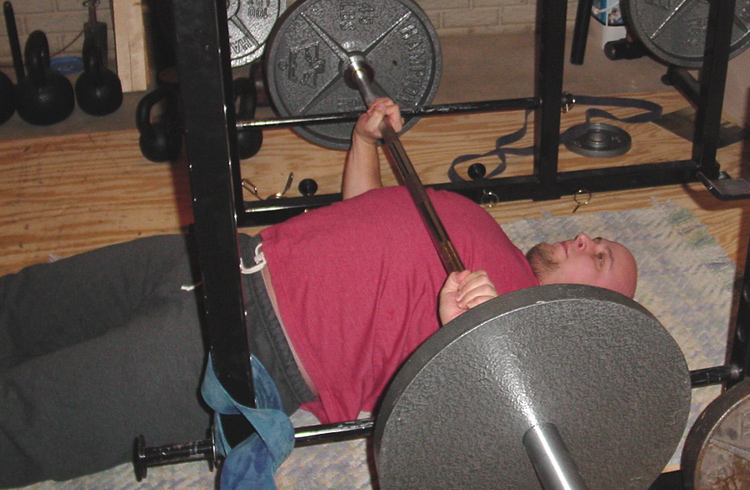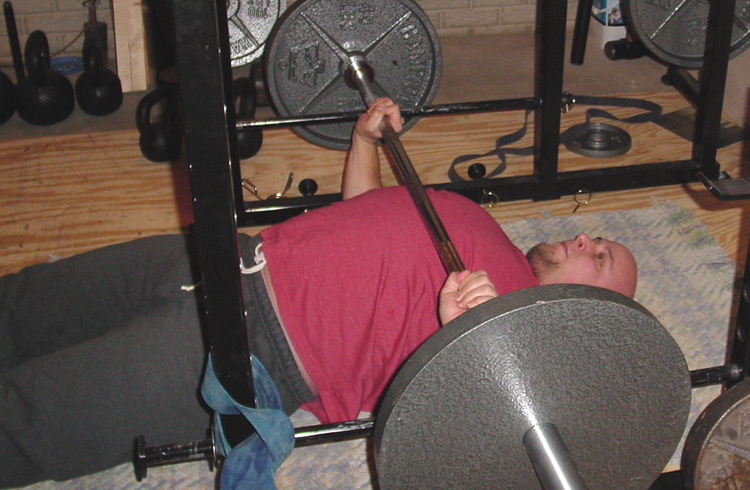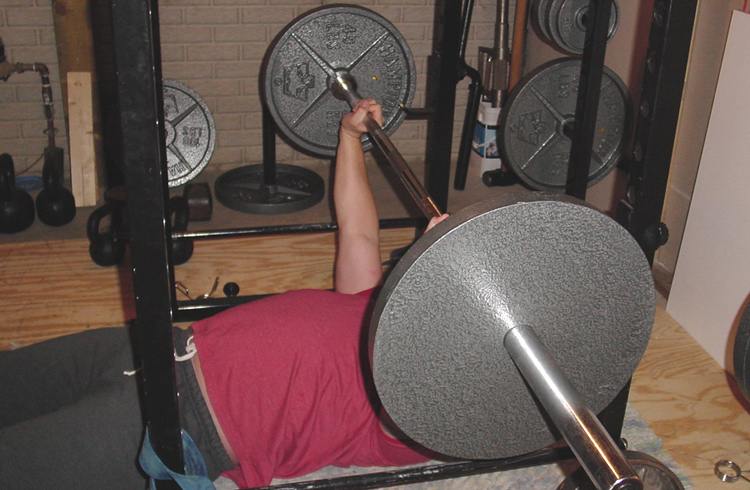The Floor Press

In late 1990s, there was an explosion of training information disseminated on the internet, especially for powerlifters. Prior to this, learning new exercises and techniques depended on conversations with other lifters during and after meets, tips gleaned from the rare periodical or book you found that dealt with strength training, or old-fashioned trial and error.
It was during this timeframe that we saw the rise in popularity of the current reigning meme in powerlifting training—that of the Westside Barbell Club, under the guidance of the eclectic and inquisitive mind of "The Mad Monk of Powerlifting", or Louie Simmons, as a T-mag interview coined him.
When it comes to improving your powerlifting total, Louie Simmons is a driven man. His contacts range far and wide, from ex-Soviet Olympic Weightlifting coaches, physical therapists, and elite level strength sport athletes spread across the nation. One of these athletes, elite powerlifter Jesse Kellum, had resurrected an archaic variation of the bench press and put it to good use in his training, and suggested it to Louie. Louie was extremely impressed with the lift, and it became a staple in his maximal effort rotation. This movement is the floor press.
How to Perform the Floor Press
The floor press is a simple movement—it's a bench press performed while lying on the floor. It should be performed in a power rack, with safety pins set to catch a missed lift, or with the aid of a knowledgeable spotter. The set up should be similar to that of the bench press:
1. Lie down on the floor with your legs straight out and grip the bar.
2. Arch the back and squeeze the shoulder blades together.
3. Unrack the bar and move it forward until it's above your chest, preferably towards the xiphoid process of your sternum.
4. Lower the bar until the elbows contact the floor. It will probably be helpful to think about pulling the bar down with your back and lats. You can also think about attempting to bend the bar in a "U" shape during the entire process.
5. Pause for a brief interval, then press back up. Attempt to press it straight up, with a minimal amount of drift towards your head.


The floor press is also featured prominently in Pavel Tsatsouline's Power to the People, p105-108, 1999. An exemplary explanation of the movement is included in the book. The legs should be kept straight to minimize any leg drive that occurs when the feet are able to press against the floor. For the neophyte lifter, this probably doesn't matter, but the experienced bencher knows how to develop and use leg drive. You will find that when it's performed strictly, the floor press is a test of raw, brute pressing power. In most cases, the floor press loads should be lower than the bench press, due to the elimination of the stretch reflex. This is one of my slowest, hardest "grind" lifts in the ME rotation for the bench press.
You can expect a few things from using the floor press. The first thing is an increase in your regular bench press, especially if your sticking point is near or at the point where the bar comes to rest in the floor press. The second thing is an increase in the strength of your triceps. This increase will help improve other movements, like the overhead press, and the push press, due to increased lockout power. And finally, the floor press will strengthen your chest.
Many people find the floor press to be easier on the shoulders than the bench press, and this is due to the shortened range of motion and to the generally lighter load. They find themselves able to continue using this kind of movement, whereas they might otherwise have had to drop it from their workouts. Others have noticed the opposite—that starting the movement from a dead stop is harder on the shoulders. Either way, you need to intelligently program your use of this movement and start conservatively.
Programming the Floor Press
When first starting the floor press, it is, in my opinion, essential to start light. I prefer to start with more sets of fewer repetitions. Instead of 3 sets of 10, I'd consider 5 sets of 3. I find that when learning a new movement, performing more sets of fewer reps helps you learn the movement better. When first starting out, avoid fatigue.
After an initial break-in period, which should last until you are comfortable with the lift and have an idea on how your shoulder girdle will react to it, then the floor press can be used in any number of different ways.
The first is as a drop-in replacement for the bench press. Just substitute the floor press for the bench press, and continue on your merry way. Any repetition range may be used, though I would suggest keeping to lower repetitions. For those tired of benching, lacking a bench, or who may be finding the bench press disagrees with them, this may provide a workable solution.
The second is as an assistance movement for the bench press. The floor press is an excellent candidate for this, especially if accommodating resistance is used. Band and chains make an excellent addition to this movement, coupling the breaking of the stretch reflex with matching the strength curve of the movement. One way is to keep the bar weight constant, and adding increasing resistance via chains or bands each set. Another way is to keep the chain or band resistance constant, and increase the bar weight each set. Anecdotal experience points to the first method as being more valuable for improving the bench press lock out.
The third way the floor press is used, which is also the most common, is as a maximum effort (ME) movement within the Westside Barbell template. You would work up to daily maximal attempt, usually for 1 repetition, but occasionally for a 3 or a 5 repetition maximum. This will strengthen the midrange of the bench press for many lifters, and, if you have a thick torso or short arms, this may also strengthen the start.
As a side note, the floor press can be performed with dumbbells and even kettlebells. These implements are generally more suited as secondary movements and for higher repetitions.
Go Forth and Press
The floor press is a simple yet effective exercise both by itself and as a tool to increase the bench press. It's useful for both shirted and raw bench pressers. You'll find it to be a slow grind of a lift, and in that capacity it helps train the ability to finish a slow maximal bench press. The increase in triceps strength often leads to an increase in the standing press as well. The only reason not to do it is that it can be difficult and painfully slow. Give it an honest shot and see where it takes you.
It was during this timeframe that we saw the rise in popularity of the current reigning meme in powerlifting training—that of the Westside Barbell Club, under the guidance of the eclectic and inquisitive mind of "The Mad Monk of Powerlifting", or Louie Simmons, as a T-mag interview coined him.
When it comes to improving your powerlifting total, Louie Simmons is a driven man. His contacts range far and wide, from ex-Soviet Olympic Weightlifting coaches, physical therapists, and elite level strength sport athletes spread across the nation. One of these athletes, elite powerlifter Jesse Kellum, had resurrected an archaic variation of the bench press and put it to good use in his training, and suggested it to Louie. Louie was extremely impressed with the lift, and it became a staple in his maximal effort rotation. This movement is the floor press.
How to Perform the Floor Press
The floor press is a simple movement—it's a bench press performed while lying on the floor. It should be performed in a power rack, with safety pins set to catch a missed lift, or with the aid of a knowledgeable spotter. The set up should be similar to that of the bench press:
1. Lie down on the floor with your legs straight out and grip the bar.
2. Arch the back and squeeze the shoulder blades together.
3. Unrack the bar and move it forward until it's above your chest, preferably towards the xiphoid process of your sternum.
4. Lower the bar until the elbows contact the floor. It will probably be helpful to think about pulling the bar down with your back and lats. You can also think about attempting to bend the bar in a "U" shape during the entire process.
5. Pause for a brief interval, then press back up. Attempt to press it straight up, with a minimal amount of drift towards your head.


The floor press is also featured prominently in Pavel Tsatsouline's Power to the People, p105-108, 1999. An exemplary explanation of the movement is included in the book. The legs should be kept straight to minimize any leg drive that occurs when the feet are able to press against the floor. For the neophyte lifter, this probably doesn't matter, but the experienced bencher knows how to develop and use leg drive. You will find that when it's performed strictly, the floor press is a test of raw, brute pressing power. In most cases, the floor press loads should be lower than the bench press, due to the elimination of the stretch reflex. This is one of my slowest, hardest "grind" lifts in the ME rotation for the bench press.
You can expect a few things from using the floor press. The first thing is an increase in your regular bench press, especially if your sticking point is near or at the point where the bar comes to rest in the floor press. The second thing is an increase in the strength of your triceps. This increase will help improve other movements, like the overhead press, and the push press, due to increased lockout power. And finally, the floor press will strengthen your chest.
Many people find the floor press to be easier on the shoulders than the bench press, and this is due to the shortened range of motion and to the generally lighter load. They find themselves able to continue using this kind of movement, whereas they might otherwise have had to drop it from their workouts. Others have noticed the opposite—that starting the movement from a dead stop is harder on the shoulders. Either way, you need to intelligently program your use of this movement and start conservatively.
Programming the Floor Press
When first starting the floor press, it is, in my opinion, essential to start light. I prefer to start with more sets of fewer repetitions. Instead of 3 sets of 10, I'd consider 5 sets of 3. I find that when learning a new movement, performing more sets of fewer reps helps you learn the movement better. When first starting out, avoid fatigue.
After an initial break-in period, which should last until you are comfortable with the lift and have an idea on how your shoulder girdle will react to it, then the floor press can be used in any number of different ways.
The first is as a drop-in replacement for the bench press. Just substitute the floor press for the bench press, and continue on your merry way. Any repetition range may be used, though I would suggest keeping to lower repetitions. For those tired of benching, lacking a bench, or who may be finding the bench press disagrees with them, this may provide a workable solution.
The second is as an assistance movement for the bench press. The floor press is an excellent candidate for this, especially if accommodating resistance is used. Band and chains make an excellent addition to this movement, coupling the breaking of the stretch reflex with matching the strength curve of the movement. One way is to keep the bar weight constant, and adding increasing resistance via chains or bands each set. Another way is to keep the chain or band resistance constant, and increase the bar weight each set. Anecdotal experience points to the first method as being more valuable for improving the bench press lock out.
The third way the floor press is used, which is also the most common, is as a maximum effort (ME) movement within the Westside Barbell template. You would work up to daily maximal attempt, usually for 1 repetition, but occasionally for a 3 or a 5 repetition maximum. This will strengthen the midrange of the bench press for many lifters, and, if you have a thick torso or short arms, this may also strengthen the start.
As a side note, the floor press can be performed with dumbbells and even kettlebells. These implements are generally more suited as secondary movements and for higher repetitions.
Go Forth and Press
The floor press is a simple yet effective exercise both by itself and as a tool to increase the bench press. It's useful for both shirted and raw bench pressers. You'll find it to be a slow grind of a lift, and in that capacity it helps train the ability to finish a slow maximal bench press. The increase in triceps strength often leads to an increase in the standing press as well. The only reason not to do it is that it can be difficult and painfully slow. Give it an honest shot and see where it takes you.
|
Steve Shafley has competed in Powerlifting, Olympic Lifting, Strongman, and Hand Strength competitions, not doing particularly well at any of them, but before that, he played rugby for over a decade. He holds a BS in Biology, and has spent a significant amount of time working in the chemical industry. |
Search Articles
Article Categories
Sort by Author
Sort by Issue & Date
Article Categories
Sort by Author
Sort by Issue & Date

